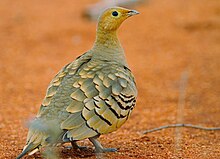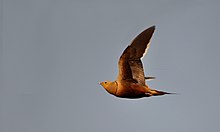This is an old revision of this page, as edited by Archon 2488 (talk | contribs) at 21:39, 18 August 2015 (add convert template). The present address (URL) is a permanent link to this revision, which may differ significantly from the current revision.
Revision as of 21:39, 18 August 2015 by Archon 2488 (talk | contribs) (add convert template)(diff) ← Previous revision | Latest revision (diff) | Newer revision → (diff)
| Chestnut-bellied sandgrouse | |
|---|---|

| |
| Conservation status | |
 Least Concern (IUCN 3.1) | |
| Scientific classification | |
| Kingdom: | Animalia |
| Phylum: | Chordata |
| Class: | Aves |
| Order: | Pteroclidiformes |
| Family: | Pteroclididae |
| Genus: | Pterocles |
| Species: | P. exustus |
| Binomial name | |
| Pterocles exustus (Temminck, 1825) | |
The chestnut-bellied sandgrouse (Pterocles exustus) is a species of sandgrouse. They are found in sparse, bushy, arid land which is common in central and northern Africa, and southern Asia. Though they live in hot, arid climates, they are highly reliant on water. They have been known to travel up to 80 kilometres (50 mi) in one day in search of water. All species of sandgrouse that have been studied in habitat have proved to entirely vegetarian throughout their lives, specialising in leguminous weed seeds and seldom eating grass seeds.


In the 1960s many birds were captured using clap traps from Rajasthan in India and introduced into Nevada. They have also been introduced to Hawaii.
A subspecies, P. e. floweri, was last seen in the Nile Valley of Egypt in 1979. It is thought to be extinct, but the reasons for this are unknown.
References
- Template:IUCN
- Christensen, Glen C. (1962) Use of the Clap Net for Capturing Indian Sand Grouse. The Journal of Wildlife Management. 26(4):399–402.
- Hume, J. P.; Walters, M. (2012). Extinct Birds. London: A & C Black. p. 133. ISBN 1-4081-5725-X.
External sources
This bird-related article is a stub. You can help Misplaced Pages by expanding it. |